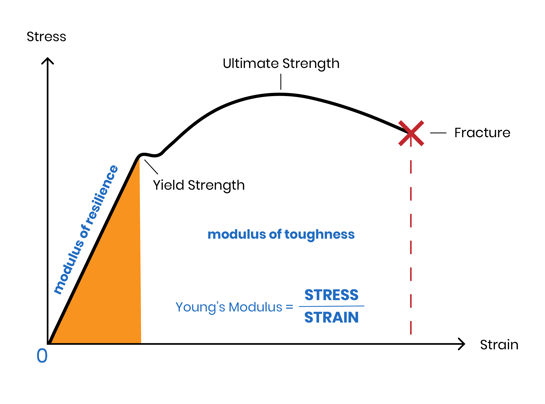Every time you drive down the road and see suspended utility cables, you’re observing Young’s Modulus in action. The raised utility wires have a high modulus and are retaining their shape, even under the high pressures of aerial suspension and weather.
Young’s Modulus Explained
Young’s Modulus/Initial Modulus is the initial part of a stress/strain curve and describes the ability of a wire, cable, yarn, or thread to resist elastic deformation under load. It describes a material’s propensity to retain its shape, even when it is being stretched, pulled, twisted, or compressed.
When a material has a high modulus, even under extreme strain the material resists the initial force and recovers well. For a lower modulus material, strain stresses it and creates the risk of breaking, which is illustrated in the stress-strain curve below.

The ratio of stress to strain is the elastic modulus—stiffness, only the stress, defines the strength of a material. Stiffness measures the resistance to elastic deformation, whereas strength measures how much stress the material can handle before permanent deformation or fracture occurs.
Force and Deformity
There’s also the question of permanent deformity. A high modulus yarn can withstand more initial force, even under repeated bouts of pressure and release, without showing permanent deformity of its shape.
A low modulus yarn isn’t as resilient. Even when the force subsides, the low-modulus material has a hard time recovering and snapping right back into shape.
Let’s go back to our example of suspended utility cables. It’s easy to see why a high modulus yarn is strongly preferable in the wire and cable industry, where the safety of utility workers and the general public is always a concern.
A high modulus reinforcement prevents aerial cables from sagging due to creep from the sustained load as well as helping to withstand windy conditions. With a low modulus reinforcement, the cables wouldn’t be as resistant to strong winds and could stretch far enough to impact a vehicle or person nearby or even break causing utility downtime, sagging to this extent would most certainly affect transmission performance of the cable in question as the glass would have fractured.
High Modulus Materials
A high modulus is preferable in a wide variety of industrial and commercial materials for purposes of resilience, safety, and reliability. Because of the more desirable tensile characteristics for specific applications, high modulus material variants are often more expensive than standard modulus materials and may not be as readily available.
For example, DuPont™ Kevlar® Para-Aramid is a fiber that comes in both standard and high modulus varieties. While both varieties have similar basic chemical compositions, melting point, decomposition temperature, specific gravity and breaking tenacity, however the higher modulus along with the lower elongation at break are the desired properties based on end-use.
High modulus yarns are often the best choice for any load bearing or strength member application where there will be constant stress on the end product.
The following benefits make high modulus aramid desirable:
- Resistance to stress from weather and environment
- Retention of strength under static and constant loads
- Longevity of installations, particularly in wire and cable
- Strength, at five times stronger than steel pound for pound
- Strong but not bulky
- Stable without degradation at a wide range of temperatures
- Low flammability and no melting point
Terms Related to Young’s Modulus
Here’s a quick guide to some terms that are often used when discussing Young’s Modulus.
Stress: A tension created by the application of a lengthwise load.
Strain: Change in length from stress acting parallel to the longitudinal axis of the material.
Creep: This is time-related, non-recoverable damage due to sustained stress.
Fatigue: Fatigue is when a material weakens due to repeatedly applied loads.
Stiffness: A stiff material has a high Young’s Modulus.
Deformation: Also known as plastic deformation, this is the warping that occurs under stress.
Elastic limit: This is the limit beyond which the material is deformed.
Yielding: Just beyond the elastic limit is permanent deformation known as yielding.
Strain Hardening: Beyond yielding, this is a maximum or ultimate stress.
Fracture: Beyond ultimate stress is the fracture, or breaking, point.
The modulus of a particular textile fiber can always be measured and is commonly expressed by gram-force/denier (gf/den).
If you need more information and advice about selecting industrial yarn with the right modulus, Service Thread processes a wide variety of fibers and offers products with various physical properties. To find out what will work best for your application, connect with our experts for details.



